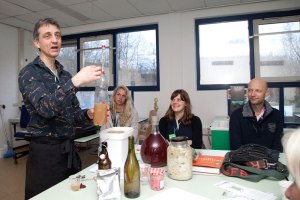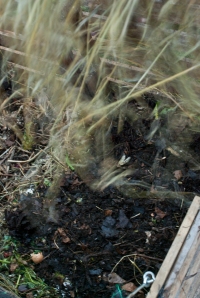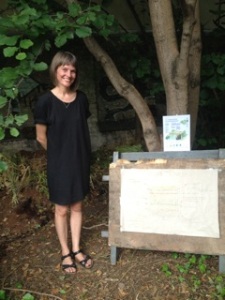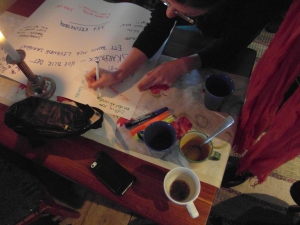Mind Mapping in Berlin
After coming back to Berlin, Abubacarr took the initiative to test out the Mind Mapping method we obtained in Rotterdam, with a group of people affected by multiple discriminations. Our Mind Mapping session focused on the question: What can I do in order to increase my own social/economical situation? And we implemented the method as a brainstorming session.


After personal ideas were grouped into common goals, those individuals with common ideas, worked together in smaller groups. In doing this, the following idea stood out: To develop projects for the cooperation with the participants countries of origin. A number of the individuals involved were motivated to meet again and to start work on the further development of these projects. For the next meeting we are planing to make use of the Open Space method.
With best wishes from Berlin Abubacarr & Lina
/////////////////////////////////////////////////////////////////////////////////////
Mind Mapping in Skarpnäck / Stockholm
We organized a workshop regarding our trip to Rotterdam. It was surprising many who showed up. We had not at all expected, it was to go and buy more cakes simply!
We started by going through the journey garden for garden and so we finished with a small workshop in Mind Mapping (view map), the method that we had to learn from the Dutch.
We divided all in four groups and so we explained how this version of Mind Mapping works:
1. Everyone has a blank paper. Where we wrote down the substance of the mind map. We chose to have the topic “how we can interact more with Bagisodlarna (a garden in another neigborhood)
2. Everyone gets paper. On them, a write down the different proposals on how it will be achieved. And everyone must be silent during this first part.
3. Now a change paper together and put stars on the proposals you think is best. But one can only use three stars overall. This will also happen in silence.
4. And now a talk! What proposals received the most stars? All groups had to tell the other groups about which proposals which received the most stars.
And now we have a lot of good suggestions on how to samkväma with neighboring farms in the locality. Good view maps !!!
With best wishes,
Mikaela and Ida // Folkodlarna i Skarpnäck //
/////////////////////////////////////////////////////////////////////////////////////
Fermentation workshop at “ER Groeit Festival” in Rotterdam
On the 14th of February 2015 a group of volunteers organised the “ER Groeit Festival”. It was the 3rd edition of this urban agriculture festival organised by Edible Rotterdam. The idea behind the festival is that local urban farmers can exchange their knowledge with other people interested in urban farming and all it facets.
In the morning there where 18 workshops devided in 2 slots of one hour for every workshop.
During this session we also held our fermentation workshop. It was a big succes since all the 12 available spots for the workshop where booked more than a week in advance!
Not just people from Rotterdam participated in it, but also visitors from other places in the Netherlands. After the workshop the participants got to take one jar of fermented vetgetables with them.
With best wishes from Rotterdam,
Stefan
//////////////////////////////////////////////////////////////////////////////
Composting in the community garden “Matparken” in Stockholm
In the beginning of April we had our compost course in Matparken (the foodpark). It was joined event, between Folkodlarna and Global Playground Stockholm, the new group that has taken over Matparken since January this year. We had a lot of fun hanging out and acting together!!
The compost was mixed with a lot of soil that people from the neighborhood had thrown in with plants and other stuffs.
So we began with clearing a new space for the compost and then started to mix the old compost with new material. And we also got food compost from the Collective house `Tre Portar` that we also mixed in the new compost. We did layers with old compost, new food compost and some leaves, branches and dry stuff.. We found alot of worms so the compost was really working.
And we ended the course with some nice fika!!!
With warm greetings,
Mikaela and Ida – / Folkodlarna i Skarpnäck /
//////////////////////////////////////////////////////////////////////////////
Fermentation testing in Berlin – Exchanging knowledge at residential home for the elderly
As the art of fermentation is old and is now being rediscovered by interested urban activists we thought of exchanging and broaden our knowledge with elderly people.
During their childhood different preservation techniques were essential for the nutrition of the family since fridges did not exist then, nor was there the abundant and always available variety of food as we are used to today.
With that said we decided to take the chance and connect with a retirement home to produce our first self made Sauerkraut at the end of February 2015. The group we worked with is composed by dementia patients. Our hope was to stimulate their knowledge from earlier times and give them the chance to contribute their own experience on the topic.
Urban garden activists from Glogauer 13 and residents participated actively in cutting, salting and kneading the cabbage until it was watery enough to be filled up. One resident who is a former boxer evidently had a lot of fun punching the cabbage in order to get more juice out of the cabbage so that the lactobacillus can be activated. Some others began to tell stories from when they were kids and to talk about other recipes they had in mind.
Some others again just enjoyed the relaxed and pleasant atmosphere during the activity.
The event was a full success! Not only could we test our receipt for the Sauerkraut, but also we found a new cooperation partner for more activities in the garden in the future. Thanks a lot to the group of participants!
Cutting the cabbage…
After having added 2% of salt we can start to massage the cabbage…
After massaging the cabbage for a while it is already starting to water. Pressing the cabbage in order to prevent air bubbles so that an anaerob fermentation is granted..
The result! Six weeks from now the residents will have a look at the cabbage to see if it is ready to be enjoyed. In the meantime the glass is kept in a dark and cool place in the basement.
With best wishes Emita, Julia & Carsten from 
*** It was not possible to photograph the faces, as we would have needed to get the permission from the relatives ***
/////////////////////////////////////////////////////////////////////
Testing the method “fermentation” at the “Stadiongarten” in Zurich
On a very sunny afternoon in October 2014 a group of people gathered at the Stadiongarden, the aim was to produce “Sauerkraut” due to the workshop we had in September in Stockholm. We had a lot of different vegetables slicers, including a real old “Krauthobel” and a ceramic “Sauerkrauttopf”, sharpe knifes and a lot of cabbages {12 kg} and spices and slat.
First of all we cleaned all tools and the work surface with boiling water, and washed our hands several times, also during the whole process. We cutter the cabbage into pieces after we shaved it and put a layer it into the pot where we added salt and the spices {juniper berries and caraway seeds}.
Then we mashed the cabbage heavily with a spontaniously constructed tool for dehydrating the cabbage.
This way {layer after layer} we went on for hours until we finally had all the cabbage in the pot. We covered the cabbage with cabbage leaves and put stones to weight it down because the Sauerkraut always has to be covered with salty water due to the anaerob lactic fermentation process. In the end we added different lactic acid bacterias in a water solution for providing a good fermentation process.
We closed the pot with the lid and filled up the channel along the lid with water. Like this, gas can leave the pot, but no gar can enter into the pot.
For the days we will keep the pot on room temperature, afterwards we will keep the pot for 4-6 weeks on max 10°C. Then the Sauerkraut should be ready to eat.
Good, healthy and conscious appetite!
On behalf of Zurich Team – Wanda.
/////////////////////////////////////////////////////////////////////////////////////
Composting at the community garden “de Esch” in Rotterdam
On a nice evening we got together to work on our composting method. We started with refreshing the basic of composting and discussing together how, where and what to compost in our garden. Why compost is needed?
The compost we had has wooden parts in it; we sifted it to separate the finished compost. A job that needs many helping hands, and made place for a new compost pile. After depositing the finished compost in the planting bed we got to start filling a new compost pile. Layer after layer we build up nitrogen-rich and carbon-rich layers, to get a nice mixture and hopefully nice good smelling an fertile compost.
When we ran out of materials and the sun started to set, a new compost pile was forming and we had learned a thing or two about composting. It was a good evening with a lot of discussions and exchanges to topics about the food systems and diverse environmental issues.
With best wishes – the Rotterdam Team!
////////////////////////////////////////////////////////////////////////////////////
Composting in the community garden Glogauer13 in Berlin
7th July 2014
Back home from Zurich in Berlin, Lina Stuzmann and Tania Kelley took initiative to use the method of composting in the community garden G13.
During the weekly working days on Wednesdays and Saturdays the Zurich way of composting was discussed with other members of the garden and adapted to the local circumstances, a new approach was developed and a compost heap collectively build.
During the summer party of the community garden G13 on 5th of July 2014
the compost was presented for a broader audience, the composting-method reflected and experiences made in frame of the LEARNACT project were exchanged.
Compliments of the season, Lina
////////////////////////////////////////////////////////////////////////////////////
Interview with Lina Stuzmann member of Spreeacker and founder of Glogauer13 garden Berlin
15th April 2014 Berlin, Tania Kelley
Lina Stuzmann, Tania Kelley / Photo: Kaspar Vollenweider
Tania: How did you come to be involved in these two community garden projects?
Lina: I heard about the project around the time I started with the Spreeacker garden in late 2011/12. The community house building project, that is taking place on the land where Spreeacker is located, had put out tenders for projects to make use of the space during the construction process and/or possibly longer. The garden idea was one of a number that were selected
With the Glogauer 13 garden, I had heard through the transition town initiative that there was a vacant sports ground that was no longer in use. They had had the idea to set up a community garden but lacked the man power. So with a friend of mine we investigated the possibility of starting a community garden there. It took two years of asking the local council if we could use the space and it wasn’t until we had won a prize form the Deutsche Umwelthilfe that we received any concrete response to our request. Deutsche Umwelthilfe helped with communication with the council and the prize provided an obligation for the council to comply. That was the catalyst for the initial formation of the garden.
At first we were given a 5 year interim use contract then a few weeks later we were told we may not be able to use it at all because they planned to build a kindergarten there. We went ahead with the initial meeting, which around 50 people attended, and decided to start anyway, even though it was unsure how much time we would have. In 2013 we received an official contract for the duration of 1 year.
The garden started without a fixed concept or plan, other than it would be an open space for people to come together and plan and create something together, A place to exchange knowledge or experience and to allow the people involved to create from their own resources. A self organized, bottom up approach.
After the first meeting of 50 or so people, we had a map of the wishes, resources and interests of the group and the next meeting took place in the garden to discuss what we would need to start. It was a very organic start to the garden with a high fluctuation of participants. but by the following year there was a core group, who have stayed and have put a lot of work into the organization and current structure of the garden.
We soon realized this interested parties would not reflect the cultural diversity of the neighbourhood, which has a high Turkish population, and this was one reason for joining this program. We wanted to discover more low threshold methods and hear others experiences in involving local cultural groups that have not integrated so easily.
Tania: What were the highlights of the last LEARNACT trip to Zurich?
Lina: Simply meeting like minded people interested in the same topics. Knowing that we are not alone in this, that there is a wide community within Europe that are organizing themselves in such ways. And Zurich was an inspiring example of how the municipality can work in cooperation and support community gardens. Allowing these spaces to exist and seeing the benefits for all parties.
Tania: You are referring to the council and Grüne Zürich representative, Mr. Rudi Winkler?
Mr. Rudi Winkler / Photo: Kaspar Vollenweider
Lina: Yes. Meeting and hearing Rudi Winkler. helped me see that the co-operation between the municipality doesn’t depend so much on the amount of money a city or state has but more so the political focus and more importantly the personal interest and support of individual politicians. If there is an attitude that it can be a fruitful collaboration for whatever personal or political reasons then they are more inclined to help and facilitate such projects. However In Zurich, although they are so open and supporting there is still the problem that most projects are interim projects and thus will only exist until the land is sold or development plans are made. A crucial topic for the future will be how to facilitate urban gardens in a more permanent way, like seeing how they can be integrated into the city planning. Plus who decides on the uses of public space is still a big topic.
Tania: How did this change or alter your perspective of setting up a community gardenTania: in Berlin?
Maybe it would be worth deepening the relationship with the council by strengthening personal and sympathetic contacts, as a way to foster more supportive for our and other community gardens. On the other hand it may be best just to leave them in peace or not disturb them too much. let sleeping dogs lie as they say.
The initial response setting up glogauer13 was very slow and irregular. Maybe if we had been pushier they may have reacted sooner but I strongly feel the Berlin municipality sees such things as just extra work and are reluctant to do anything unless necessary. So perhaps if we had pushed we may have gotten a no. It’s hard to know.
Tania: How did things change then when you got the prize?
Lina: After that they were obliged to answer, as the power of this organization was behind us, but a strong will to help was not really evident.
Tania: What for you was the most important thing you gained from this trip to Zurich?
To see other people organizing similar gardens and communities increases my motivation and I feel more convicted to the cause. To know that there are many like minded people around the world is heartening and makes me feel part of a much bigger movement. I’m happy to see there is a raising awareness of environmental and social issues and questions arising about how we want to live our lives, what we eat, and how we want to organize our cities. As well as creating modes of self sufficiency, food sovereignty, seed saving and strengthening local communities. A renewed commitment to the breaking down of boundaries and fighting against the alienation of big cities and the city / country divide.
/////////////////////////////////////////////////////////////////////////////////////
Open space workshop at Bergholmstorpet / Skarpnäck / Sweden /
25th January 2014
We wanted to do a workshop with open space. And so, we merged it with, first tell you about our Berlin trip so people could get some inspiration for the workshop afterwards. We kept to Bergholm cottage is a cottage between Skarpnack and Bagarmossen. We got coffee and soup. There were 10 people. First we talked about what we did in Berlin and showed pictures. We talked about what our project is all about and that one of the most important things was to use each country’s method to home plan. Berlin’s method was a kind of workshop method that does not exclude, more makes everyone feel comfortable to dare to be consulted about what they want to talk about.
We had hired a person who was holding the workshop and who knew little about the Open Space method. So it took over and we sat in a circle. And so did everyone write down what they would like to talk about. It was like three different subjects.
• How do we enable the people on your mailing list?
• How do we create new Kreutsneck (kruezberg team together with Skarpnack)
• Meaningful community
And then told Milla (our workshops holders), that we would go around the various tables where there was a paper on the subjects. Stay for as long as we wanted and write down how we think that we could do this stuff.
Almost everyone stopped at what to do about Skarpnack to Kreutzberg. Kreuzberg is a neighborhood in Berlin. It was there that we were when we went to Berlin. It’s like a whole different world there, with lots of art and culture. So we want to try to introduce that kind of spirit more in Skarpnäck!!!
Best,
Ida and Sara
/ Folkodlarna i Skarpnäck /



























































